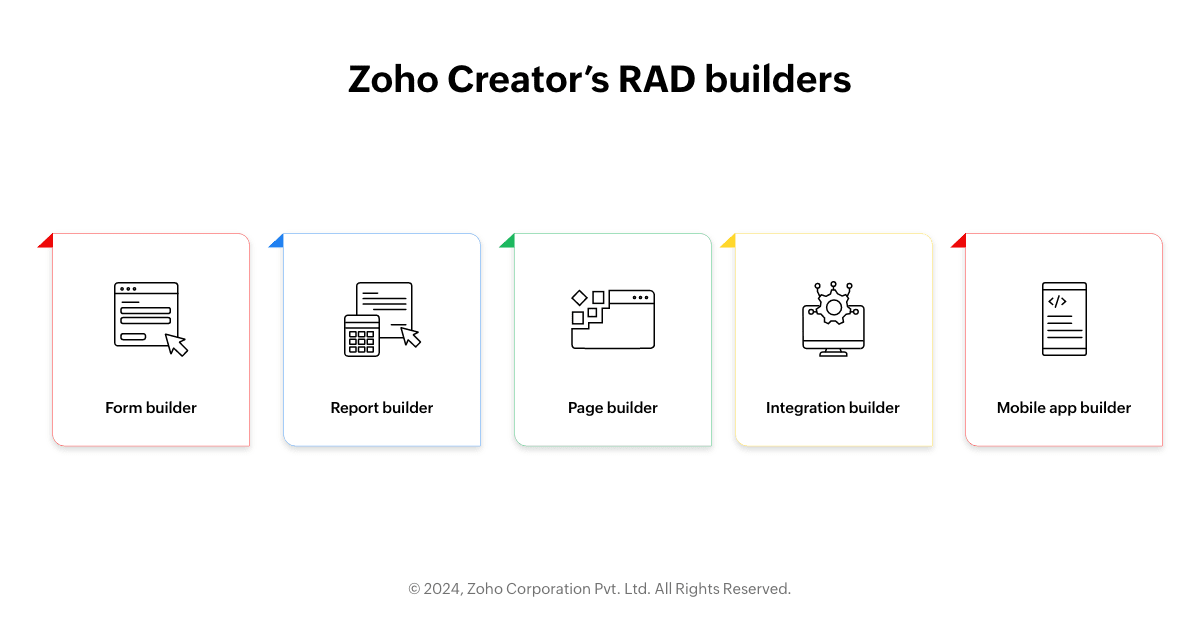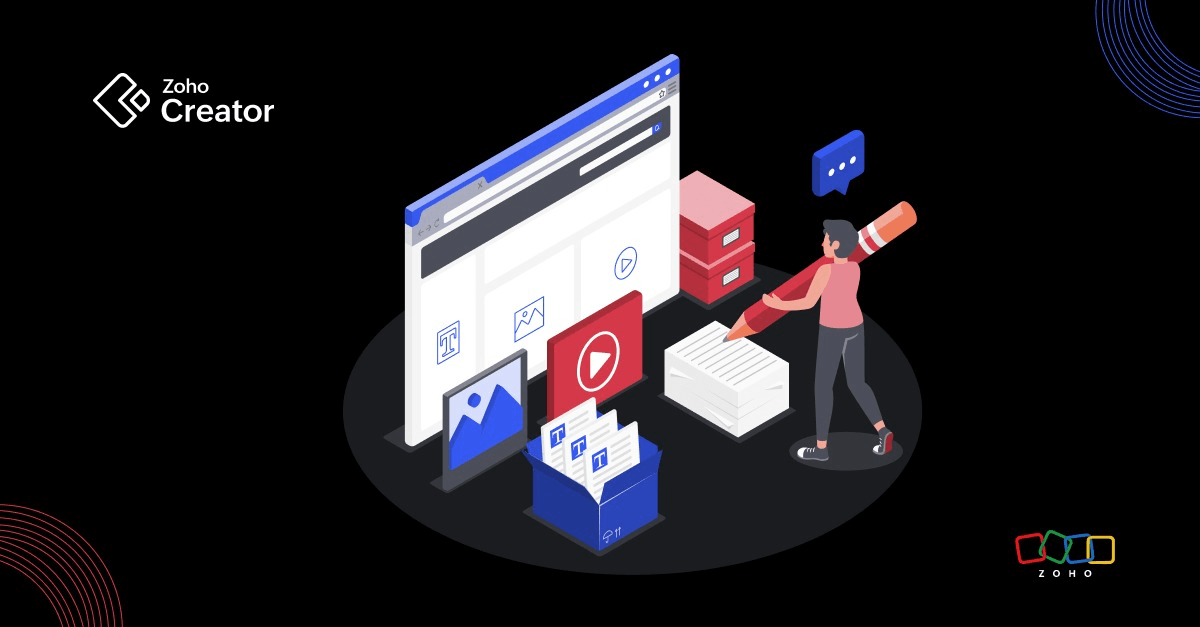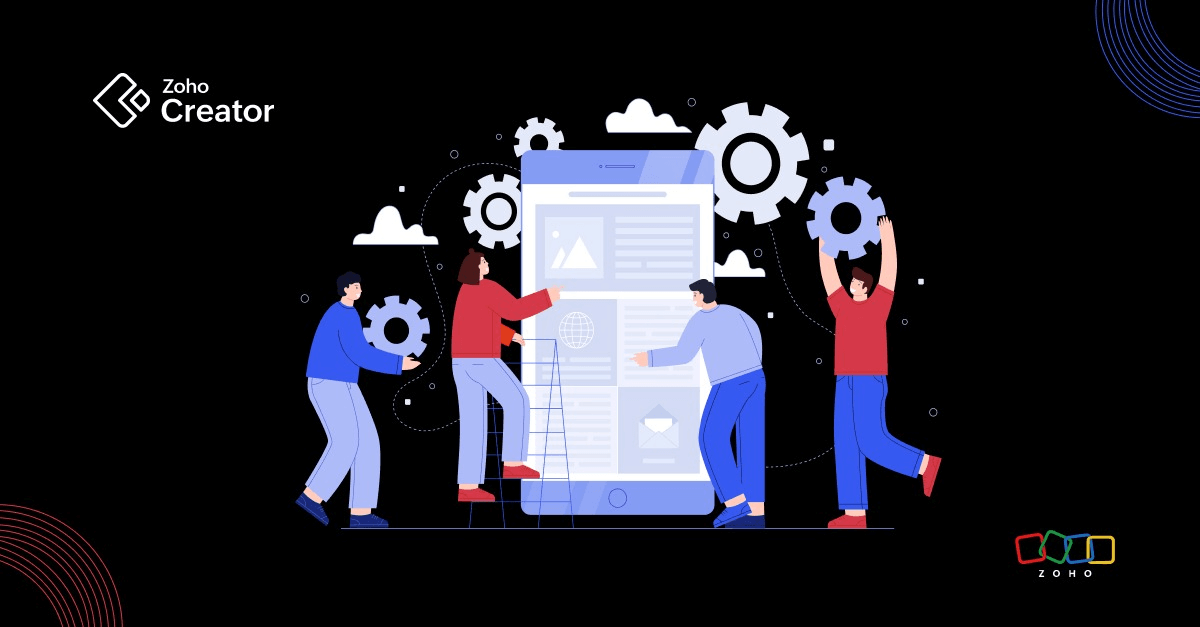- HOME
- Know Your Tech
- 6 factors for selecting a rapid application development (RAD) platform
6 factors for selecting a rapid application development (RAD) platform
- Last Updated : August 15, 2024
- 548 Views
- 11 Min Read
Rapid application development (RAD) is a software development approach that prioritizes rapid prototyping over lengthy planning phases, which enables developers to quickly adjust to changing requirements. Speed of ideation and execution is integral to the growth of any business, and time-to-market keeps shrinking with advancements in technology. The speed and flexibility of the rapid application development process aligns strongly with these objectives.
A fully contextual business process management suite built using RAD tools can drastically improve organization-wide throughput. These tools allow teams to iterate swiftly, adapt to feedback in real time, and deliver functional products faster than ever before.
This article will provide you with the essential factors to look for when picking a rapid application development tool for your business. We're here to discuss a technology that not only accelerates your development cycle but also positions you to innovate on your business processes.
Understanding RAD platforms
Rapid application development platforms are cutting-edge software development tools that simplify and accelerate the application building process. Rapid development tools are built to enable developers to create and iterate apps quickly, significantly reducing the time required to code. These tools achieve this through a variety of features, like drag-and-drop interfaces, prebuilt templates, and reusable components. Most RAD tools are built with flexibility in mind, allowing developers to pivot swiftly to changes in project requirements or market demands, ensuring that the final product remains relevant and competitive.
When the software industry shifted to agile development methodologies, it catalyzed the creation of the rapid application development process. As businesses demanded faster turnaround times and greater adaptability in projects, RAD tools emerged as a pivotal solution. They facilitate an agile approach to development by supporting continuous integration, continuous delivery (CI/CD), and iterative feedback loops.
The benefits of utilizing RAD tools are many. First, they significantly increase productivity by reducing the amount of manual coding required, allowing developers to focus on solving business problems rather than grappling with boilerplate code. This efficiency gain directly translates to faster times to market, a critical competitive edge in today’s quickly evolving digital landscape.
Moreover, RAD platforms improve collaboration among developers, designers, and business stakeholders by providing a common framework and tools that enhance communication and understanding across teams. This collaborative environment ensures that all parties are aligned, further streamlining the development process and enhancing the quality of the final product.
RAD platforms represent a paradigm shift in how software is developed, offering a solution that aligns with the needs of modern businesses like yours for speed, flexibility, and efficiency. By adopting RAD tools, you can ensure that you're quick in pivoting to market changes, ensuring your organization stays market relevant.
What are the key factors to consider when choosing a rapid application development tool?

1. Scalability
One of the primary factors to consider when selecting a rapid application development (RAD) tool is scalability. A scalable model will guarantee that, as your project expands, the underlying infrastructure can accommodate growth without needing large modifications. Long-term efficiency and cost-effectiveness are greatly dependent on how scalable the rapid application development tool you choose is.
The growth in scale that RAD tools need to support can be an increase in user numbers, transaction volumes, or data processing needs. If the platform you use is unable to meet any of those needs, you'll end up having to overhaul your systems completely.
So how can you go about assessing if a rapid application development solution is capable for the job? Here are some fundamentals to look at:
Performance under load
Do a workload stress test of the rapid application development tool in consideration. You can run this yourself by choosing a specific business process that you've determined will grow at a quicker pace compared to the rest. You can also check out what the user community of that specific platform is saying about it.
Support for future growth
How much do you estimate your business is going to grow in the next decade? Estimating your long-term growth plays a huge role in how you should go about choosing a rapid application development tool. Any pick without future expansion in mind—whether in terms of user numbers, data volume, or functionality—is going to be only as good as a shot in the dark.
Resource management
Efficient resource management is key to scalability. The rapid application development tool you choose should be able to take control of resource allocation at your business, in order to meet fluctuating business demands and ensure optimal performance.
2. Ease of use
Another significant aspect of rapid application development (RAD) tools is the ease with which users of different technical expertise can adjust to it. Low-code or no-code features are essential in empowering both technical and non-technical users to contribute effectively in the software development process.
When a larger user base in your organization finds technology accessible, you'll start to reap the benefits of democratization. This means that a larger chunk of your workforce will start taking part in the software development process without breaking a sweat, and this, in turn, will greatly benefit your business' digitization journey.
What are the factors to consider when you evaluate the ease of use in rapid application development tools? Let's see!
User-friendly interface
A clear, understandable user interface is one of the defining pillars of usability—but it shouldn't come at the cost of functionality. Good rapid application development tools will usually have straightforward layouts with clear instructions and accessible features.
Low-code/no-code
The best RAD tools use a healthy mix of low-code/no-code functionalities for business users, with the provision to cater to professional developers. Some of the basic functionalities to look for include visual programming, drag-and-drop elements, and prebuilt templates that simplify the creation and customization of applications. These features are crucial for enabling business users to build applications and workflows.
Learning curve
How hard will it be for a new user to understand and use the platform? Asking this question and testing it with a sample of your organization's users is a good point to start to assess the learning curve of the platform. Most of the rapid application development tools on the market focus on getting this aspect right, but how well it suits your organization is subjective.
Training and resources
The availability of training materials, tutorials, documentation, and customer support is another major factor when choosing a platform. Adequate training resources and community support can greatly reduce the learning curve and enhance your user experience.
Community support
It's always a good idea to look for how engaging and helpful the platform's user community is when choosing one for your business. In addition to training resources, a community can help you with troubleshooting or just learning the tool faster.
3. Integration capabilities
There's no point in having software that can't integrate with other solutions in your business' software stack, and this is just as true for rapid application development (RAD) tools. Your existing digital infrastructure should see productivity hikes when pushing a system upgrade, not compatibility issues.
A modern-day enterprise solution needs to work within a diverse technological landscape, communicating and functioning seamlessly with various systems and enterprise-grade applications. A RAD tool has to work well with these existing elements to streamline workflows and processes and facilitate data exchange, leading to improved efficiency and customer experience.
Let's take a look at some important aspects to assessing a RAD platform's integration capabilities:
Prebuilt connectors
How good is the platform when it comes to maintaining and updating prebuilt connectors to popular databases, cloud services, and third-party applications? Analyzing this before investing in a RAD platform helps in planning the time and effort required to integrate different systems and ensure that the RAD tool can quickly connect with essential services.
API support
If there's a need for customized integrations, then prebuilt connectors won't help—in this scenario, you'll require comprehensive API support. Well-documented and flexible API capabilities are integral in this case.
Custom integration options
If having API support is one thing, then the ability to create tailored integration solutions to suit legacy systems or specialized software is a whole different game. Rapid application development platforms should be capable of building customized integration tools to fit unique business needs, ensuring seamless connectivity with both modern and legacy systems alike.
Scalability of integrations
Scale of execution when it comes to handling integration loads is another huge factor when shortlisting rapid application development tools. Whenever your user base or the scope of your application grows, it's important that your integrations are tight and reliable.
4. Development speed and efficiency
What good are rapid application development tools if they don't help speed up the app development process? RAD platforms usually achieve this goal using reusable components, automated testing, and continuous deployment options.
Reusable components
Libraries of prebuilt components, which greatly speed up the app creation process, are one of the must-have functionalities of these tools. Drag-and-drop interfaces, code snippets, and auto-completion of code are just a few ways in which developers benefit from using such tools.
Automated testing
Identifying bugs early on helps save time in a not-so-obvious way. If the tool you use automates the testing process at every stage of the application development cycle, the time you waste on bug fixing is reduced dramatically.
Continuous deployment options
Another aspect that speeds up app development is a continuous deployment approach. If rapid application development tools allow for automatic deployment of applications after each update, the release process is quickened and solutions hit the market faster.
How should you ideally go about evaluating these features and their impact on development speed? Here are some ways to do it:
Trial versions
Most RAD tools nowadays offer free trails. You can use these offers to get hands-on with these tools and see which one works best for you.
Demos
It's always best to set up a demo of the platforms under consideration, because trialing it without a complete picture of the functionalities could leave you with an incomplete experience. If you can get a demo from a product expert, you'll be able to get a better perspective on how the tool can fit into your business' technology stack.
User reviews
Social proof is another way to gather information regarding the real-life benefits of a tool. User feedback can help you gauge its effectiveness in speeding up app development and can also shine a light on potential limitations, too.
5. Cost
As long as budgets exist, the cost of owning a RAD tool will remain a critical point in the consideration stage. And when we talk about application development costs, the discussions need to go beyond just the initial subscription, taking into account ongoing maintenance expenses and the opportunity cost of considering any other technology.
Subscription fees
Most rapid application development tools follow a monthly or annual subscription model. When picking a tool for your business, you have to be clear on the feature sets that are relevant to your needs and the value proposition tied to it.
Maintenance costs
When calculating maintenance costs, there are a few expenses that you have to consider. Training costs for employees, hardware maintenance costs, and software update costs are all-inclusive here.
Cost savings
Rapid application development tools can help with reducing development costs for your business. When compared to traditional development, a RAD project using low-code tools can take as little as one-tenth the resources. By speeding up the development process and reducing the need for deep technical know-how, these tools can provide significant cost savings over time.
If you want to know the true cost benefit of implementing rapid application development tools, you need to look at the total cost of ownership (TCO). The TCO will include both direct and indirect costs when implementing these tools in your business process management suite.
The components to track when assessing the TCO are:
The subscription charge or one-time purchase fees
Monthly or yearly maintenance fees
Premium or paid support costs
Training and implementation costs
Reduced work hours and downtime savings
The TCO needs to be factored in with ownership benefits and return on investment (ROI), to get a clearer picture of why you should choose the platform. Rapid application development should improve operational efficiency, enhance productivity, and contribute to revenue growth. If not, you need to reassess your approach.
Try this savings calculator and check how much you can save.
6. Security and compliance
Security and compliance are the most integral considerations when picking a rapid application development (RAD) platform—especially for applications handling sensitive information.
Security features
What are the platform capabilities to look for when it comes to security? Let's dive in.
Data encryption
Check what standards of encryption a platform provides, to make sure your data is protected from threat agents. For example, AES 256 is the gold standard when it comes to data encryption.
User authentication and authorization
Authentication mechanisms, like multi-factor authentication (MFA), help confirm user identities, and this is critical to securing employee/user accounts in the organization. You'll also need to make sure that comprehensive access control measures are available in the tool. These capabilities set a control on who sees what data inside the organization's systems.
Network security
You need to account for the platform’s capability to protect against network threats. This means thinking about intrusion detection systems and secure VPNs for remote access, and then allotting budget for them.
Compliance with industry standards and regulations
The other half of security, which is equally crucial, is compliance. This is even more important for industries that handle highly sensitive information, such as healthcare, finance, and education.
Rapid application development platforms should ideally have the following sorted to even be considered:
Check for certifications
An audit of the platform's industry-recognized certifications needs to be done. Look for certifications such as ISO/IEC 27001 for information security management and SOC 2 for service organization controls. Also check for compliance with standards like GDPR, HIPAA, or PCI DSS, depending on your location and sector.
Review compliance documentation
You need to review the platform’s compliance reports or audits to be sure that they're compliant with the standards they claim to have.
Legal and compliance validation
Your legal and compliance teams need to be consulted before sourcing the platform, to evaluate whether the platform’s features align with the required legal and regulatory frameworks.
Zoho Creator: A low-code-powered rapid development platform
Zoho Creator is a low-code application development platform that lets businesses like yours build business apps rapidly, with the help of its drag-and-drop interface builders, prebuilt modules, and English-like scripting language.
Zoho Creator helps you automate your business processes with:
Form builder - Create intuitive user interfaces just by dragging-and-dropping prebuilt elements.
Report builder - Use this drag-and-drop builder to create reports and business intelligence boards.
Page builder - Design attractive dashboards to view all important information at a glance.
Integration builder - This zero-code builder lets you seamlessly integrate your applications.
Mobile application builder - Build custom UIs for mobile devices like cellphones and tablets.
Aligning with the central rapid application development principles we've detailed in this article, Zoho Creator has helped 14,000+ businesses globally build business solutions up to 10 times faster than traditional methods.

The right rapid application development tools are contextual to your business needs
All this considered, selecting a rapid application development tool is highly specific to your business—the factors we discussed have to be looked at in the context of your business use case. At the core of it, a rapid application development platform is a tool to build business process management software faster and better. These factors play a pivotal role in determining how well a RAD platform aligns with your project's requirements and organizational goals.
Your journey to select the right rapid application development platform for your business is a strategic process, and as is the case with other strategic processes, it requires very careful consideration. Get started on your platform selection process today—and while you're at it, take Zoho Creator for a spin! We provide a 15-day free trial, with no credit card details required.
Click below to delve into the world of rapid application development.
 Rohith Krishnan S
Rohith Krishnan SRohith is a product marketer at Zoho. He writes about low-code, workflow automation and follows the latest digital transformation trends. Outside work he enjoys spending time with family, watching football matches and reading about futuristic trends, in no specific order.



